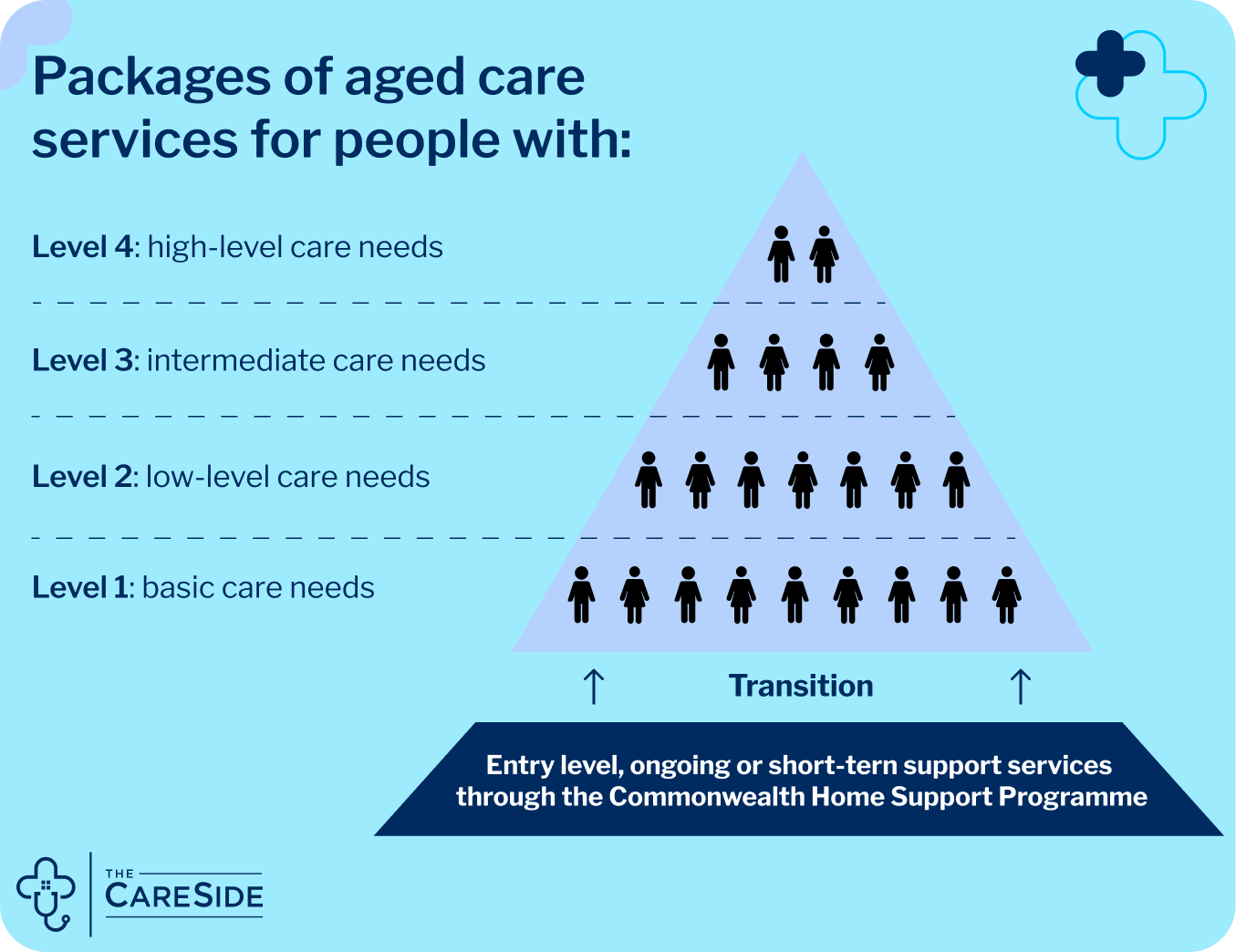Home care packages are coordinated packages of care and services. They provide support so recipients in Australia can continue to live independently while choosing the services and providers that best meet their care needs and goals.
There are four levels of home care packages, and each level includes a specific amount of government-subsidised funding. Many home care package recipients supplement that funding with their own income-based contributions, effectively increasing the amount they have to spend on the providers, services and carers they need.
Ultimately, the value of every home care package depends on the recipient’s eligibility level.
Level 3 home care packages are for older Australians who would also be eligible to enter residential aged care, but who would prefer to remain living in their own homes and on their terms.
Here’s a closer look at home care package level 3 (HCP level 3) and everything it entails.
Features of Home Care Package Level 3
Intermediate-Level Care Needs
Level 3 home care packages support recipients with intermediate-level home care, including older Australians with chronic health conditions, mobility challenges, and cognitive impairments. Depending on the provider and their fees (more on that in a bit), this package level delivers about 16 hours of care every fortnight.

Source: MyAgedCare.gov
Home Care Services
The big question is: which home care services does a home care package level 3 include?
It’s actually very flexible and up to the recipient and their personal care plan. Level 3 packages can be used for assistance with a wide variety of intermediate care needs, including day-to-day domestic and social care needs.
Some of the most common service requests at this level include:
- Personal care (such as showering)
- Basic care needs
- Domestic assistance and household tasks (such as cleaning, laundry, dishes)
- Meal preparation
- Gardening and lawn maintenance
- Medication management
- Memory and/or behaviour support
- Nursing support and/or nursing care
- Shopping
- Transport and personal assistance
- Social support and attending social activities
The Process of Acquiring Home Care Package Level 3
Eligibility: Who can apply?
Level 3 home care packages are available to Australian residents above 65 years, as well as Aboriginal and Torres Strait Islander individuals above 50 years.
Eligibility: How to apply
To apply for a level 3 home care package, Australians first need to register with My Aged Care and answer a series of questions designed to assess their care needs. (Click here to learn more about applying, or simply call My Aged Care at 1800 200 422 to start the process.)
Once the application is submitted, My Aged Care sends out an assessor from the Aged Care Assessment Team (ACAT) for a free assessment to determine the applicant’s eligibility and the best home care package level to meet their care needs. ACAT assessors—who are typically nurses, social workers or health care professionals—also provide information about local home care services and help applicants obtain the care they need.
How long does it take?
Wait times vary based on the home care package.
Upon approval from ACAT, the package recipient is added to the Australian Government’s national priority system. Individuals with more urgent care needs are prioritised to receive services first. In fact, due to national waitlists for higher-level packages, those who are assigned Level 4 home care packages might be offered Level 3 home care package funds while they wait.
| HCP Level | Approximate wait time |
|---|---|
| Level 1 | 6 – 9 months |
| Level 2 | 6 – 9 months |
| Level 3 | 9 – 12 months |
| Level 4 | 12 – 15 months |
Source: MyAgedCare.gov
The good news is, applicants who are approved for home care packages can track their wait time by contacting My Aged Care or by logging into their online account using myGov. (Click here to learn more about logging into an account.)
Applicants are notified when a package becomes available, and at that time, they can begin to engage approved providers.
Maximising the Value of Your Home Care Package Level 3
Budgeting: How to get the most from your package
The Australian Government provides a different subsidy amount for every level of home care package, and the contributions increase yearly. As of July 2023, the Government subsidy for level 3 home care packages is approximately $1,511.96 per fortnight — or $39,311 annually, calculated in daily and fortnightly subsidies.
| HCP Level | Level of care needs | Price |
|---|---|---|
| Level 1 | Basic care needs | $10,687.20 a year |
| Level 2 | Low care needs | $18,793.85 a year |
| Level 3 | Intermediate care needs | $40,905.55 a year |
| Level 4 | High care needs | $62,013.50 a year |
Source: MyAgedCare.gov
Some Australians are eligible for additional Government-funded supplements, such as veterans, individuals living with dementia and cognitive issues, or people who require oxygen services and assistance with enteral feeding.
That said, most Australians need to pay fees out of their own income in addition to the amount they receive from government subsidies.
Basic Daily Fee
A basic daily fee is a daily care fee providers can charge for their services. It changes every year in March and September. As of September 2024, the basic daily fee for level 3 home care packages is $12.75 per day.
However, some providers (such as The CareSide) choose to waive this fee.
Income-Tested Care Fee
This fee is a recipient’s contribution to the costs of their home care. It is calculated through an income assessment and can range from $18.77 to $37.55 per day, as of September 2024. Just like the basic daily fee above, the income-tested care fee is subject to change every March and September.
When individuals are asked to pay an income-tested care fee, their government-funded home care package subsidy is reduced by the amount of the fee. However, providers must still deliver services based on the full value of the home care package — in other words, the only thing that changes is the source of the funds.
Additionally, not everyone is asked to pay an income-tested care fee.
The fee is waived, for instance, for Australians who have a yearly income that’s below the maximum income a person can have to be classified as a full pensioner.
Finding the Best Providers and In-home Care
The marketplace for aged care services and home care providers is massive, and home care package recipients and their loved ones need to make sure they choose the right provider to maximise their funds.
Two simple ways to start searching for a provider include:
- Visit the My Aged Care website and use the Find a Provider tool to compare pricing, services and more
- Call My Aged Care (1800 200 422) for a list of local home care providers, which can be shared over the phone or sent in the post
When searching for a service provider for a level 3 home care package, one of the most important things Australians need to consider is how much their package subsidy covers, and how much they’ll have to pay out of pocket. Many home care providers charge additional fees on top of the two fees covered above, so asking up-front for a breakdown of costs is a crucial first step.
The best home care providers readily explain fees and break down costs in a clear, easy-to-understand manner so recipients know how much they’ll be paying—and the level of support and specialised care they’ll be receiving in return.
Still need help?
If you’re still looking for help or are confused about level 3 home care packages, contact The CareSide today by calling 1300 85 40 80 or by clicking here.
We are an approved provider managing home care packages, NDIS home support services and CHSP services, and we understand how complex care can be. Our team can help you determine the best course of action for your level 3 home care package — we’ll answer your questions, explain complicated government language, provide breakdowns of fees, and assist you with whatever else you might need!





